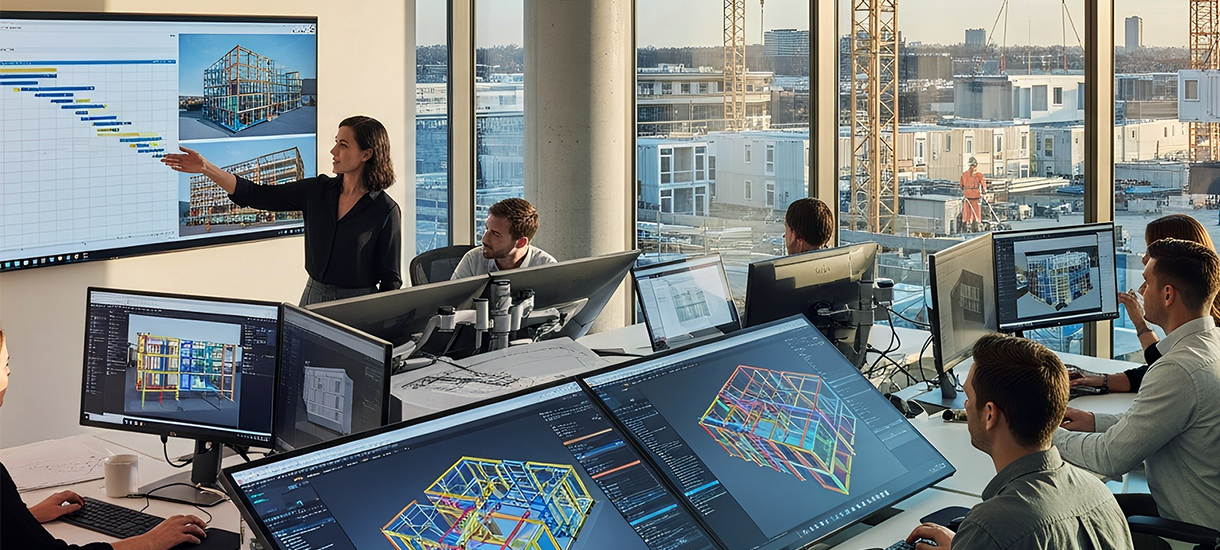Modular construction runs on accuracy, and digital tools like BIM make it possible. From structural connections to logistics, BIM streamlines design and execution, cutting errors and raising precision from the very first stages.
In light of the increasing urban density and the simultaneous rise in demand for expedited building processes, digital innovation, and sustainable, resilient construction practices, modular construction is experiencing significant growth. The implementation of Building Information Modeling (BIM) can further enhance the well-known benefits of this method, including quality and precision, durability, on-site safety, fast project completion, and sustainability.
A recent study[1] found that using BIM tools such as Autodesk Revit, Tekla Structures, and Navisworks in prefabricated modular projects not only enhanced dimensional accuracy and ensured component alignment within Indian Standard (IS) tolerance limits but also reduced on-site construction time by up to 50% through 4D sequencing and early clash detection. These findings confirm that investing upfront in modeling and coordination directly translates into efficiency, safety, and precision during execution.
The true value of BIM in modular projects lies in its ability to prevent costly mistakes, rework, structural failures, and delays—all key concerns in today's construction industry.

The importance of structural connections in prefabricated construction
Since the components of modular or prefabricated construction are manufactured off-site, transported, and then assembled, their structure requires special attention and precision to ensure a seamless fit.
By leveraging BIM to simulate assemblies, create automated production drawings, calculate accurate costs from early design stages, and enhance collaboration across disciplines, modular construction emerges as a compelling solution to today's construction challenges, ensuring safety, energy efficiency, and structural integrity during transport and assembly.
Here are the key points to consider when designing modular structures, and how BIM helps provide better solutions:
#1 Structural connections: challenges and requirements
The connections are the most critical points and require high precision and coordination. They must ensure efficient thermal joints, safe connections under seismic loads, and secure transport of components.
Structural joints between modules must be designed with the appropriate tolerances, deformation capacity, and resistance to the forces they will encounter. On this point, digital technology, especially BIM, contributes to improving:
- Detailed modeling of these connections
- Incorporation of seismic regulations from early design stages
- Simulation of load behavior
- Detection of clashes with other elements
- Design adjustments before production and assembly
#2 Thermal joints and Insulation: energy efficiency
Another key aspect when designing this type of structure is the thermal joints between modules. These joints can be affected by thermal changes or leaks. In this aspect, the value of BIM is making it easier to:
- Add these details to the model
- Assign the correct materials with the necessary insulation properties
- Predict movement and allow controlled deformation
- Analyze the impact on the building's overall energy performance
#3 Transport and assembly: structural integrity in transit
The transport and assembly of prefabricated structures are critical stages for structural integrity. During these phases, components can be affected by impacts, twisting, bending, vibrations, or misalignments.
Here, BIM methodology helps optimize the process with detailed planning of manufacturing, logistics, and assembly sequence, reducing risk and improving overall efficiency by:
- Planning safe transport routes
- Minimizing manual handling
- Defining manufacturing tolerances to ensure correct fitting
- Predicting clashes and possible surface damage or structural failures
In summary, integrating digital technologies into off-site construction is transforming the way buildings are designed and built. BIM allows early conflict detection, precise construction sequencing, and real-time collaboration among architects, engineers, and manufacturers. This reduces on-site disruptions and improves MEP system integration within modular units. This methodology also enhances supply chain transparency and supports just-in-time logistics to lower inventory and meet deadlines.
A well-developed BIM model serves as a quality guarantee for us from the very beginning of the design process. Investing today in precision pays off on-site, translating into increased safety, better budget control, and a successful outcome.
[1] BIM-enabled prefabricated modular construction: Feasibility and structural insights, Sandeep Pannu and Jitender Hooda, International Journal of Civil Engineering and Construction 2025: BIM-enabled prefabricated modular construction: Feasibility and structural insights